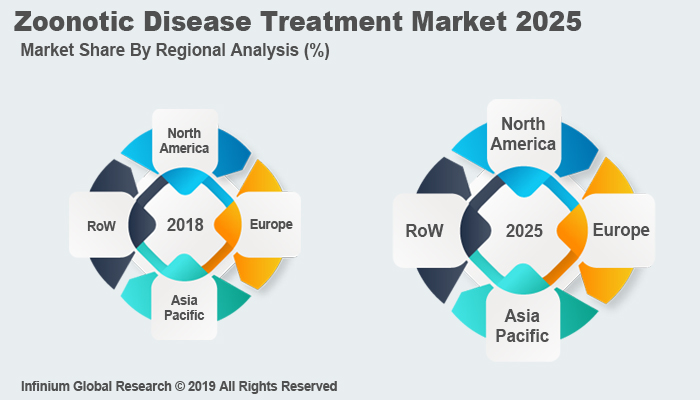Zoonotic Disease Treatment Market (Disease Type - Rabies, Viral Hepatitis, Tuberculosis, and Other Disease Types; Drug Class - Antibacterial Medication, Antibiotics, and Other Drug Class; End-user - Hospital): Global Industry Analysis, Trends, Size, Share and Forecasts to 2025
A recent report published by Infinium Global Research on
zoonotic disease treatment market provides an in-depth analysis of segments and
sub-segments in the global as well as regional zoonotic disease treatment
market. The study also highlights the impact of drivers, restraints, and macro
indicators on the global and regional zoonotic disease treatment market over
the short term as well as long term. The report is a comprehensive presentation
of trends, forecast and dollar values of global zoonotic disease treatment
market. According to the report, the global zoonotic disease treatment market
is projected to grow at a healthy CAGR over the forecast period of 2019-2025.
Market Insight
Zoonotic diseases are very common around the globe.
According to the centers for disease control and prevention, it is estimated
that every year, tens of thousands of Americans will get sick from diseases
spread between animals and people. Moreover, rapid growth in population coupled
with intense urbanization is likely to enhance the zoonotic diseases in the
coming years. Additionally, poor sanitation rate in the urban area led the zoonotic
disease, which in turns, drives the global zoonotic disease treatment market.
Apart from this, increasing demand for animal proteins is likely to increase in
the consumption of animal fats which in turn is expected to propel the growth
of zoonotic disease treatment market. Furthermore, pets offer and entertainment
and companionship with millions of households having one or more pets. However,
some animal carries harmful germs that can be shared with people and cause
illness is expected to drive the growth of the same. However, lack of awareness
about this zoonotic disease among developing countries and high capital
required for research and development could restrain the growth of zoonotic
disease treatment market. Going further, novel drugs developed for specific
animal healthcare demands creates beneficial opportunities for the global
zoonotic disease treatment market in the coming years.
Among the geographies, the global zoonotic diseases
treatment market is segmented into North America, Europe, Asia-Pacific, and RoW.
North America dominates the zoonotic disease treatment market throughout the
forecast period. Well-established healthcare infrastructures and enhanced
healthcare expenditure are some factors responsible for the growth of the
market in this region. Furthermore, Asia-Pacific zoonotic disease treatment
market shows significant growth rate throughout the forecast period due to
increasing incidences of zoonotic diseases and lack of proper sanitation
services. Moreover, the Middle East and Africa are expected to show moderate
growth rate for zoonotic disease treatment market throughout the forecast
period.

Segment Covered
The report on global zoonotic disease treatment market
covers segments such as disease type, drug class, and end-user. On the basis of
disease type, the sub-markets include rabies, viral hepatitis, tuberculosis,
and other disease types. On the basis of drug class, the sub-markets include
antibacterial medication, antibiotics, and other drug class. On the basis of
end-user, the sub-markets include hospital.
Companies Profiled:
The report provides profiles of the companies in the market
such as Cadila Healthcare Ltd, AstraZeneca plc, F. Hoffmann-La Roche AG,
GlaxoSmithKline plc, Johnson & Johnson, Pfizer Inc., Novartis International
AG, Sanofi S.A., and Other Companies.
Report Highlights:
The report provides deep insights into the demand forecasts,
market trends, and micro and macro indicators. In addition, this report
provides insights into the factors that are driving and restraining the growth
in this market. Moreover, The IGR-Growth Matrix analysis given in the report
brings an insight into the investment areas that existing or new market players
can consider. The report provides insights into the market using analytical
tools such as Porter's five forces analysis and DRO analysis of zoonotic
disease treatment market. Moreover, the study highlights current market trends
and provides forecast from 2019-2025. We also have highlighted future trends in
the market that will affect the demand during the forecast period. Moreover,
the competitive analysis given in each regional market brings an insight into
the market share of the leading players.
